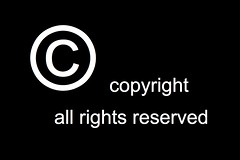Educators and Mass Media - A Reflection
 |
| "Copyright Symbols" (CC BY 2.0) by MikeBlogs |
As educators we need to be mindful when using the work of others, and also appropriately model this to our students. This is part of practicing and modeling ethical behavior, which is important to the idea of citizenship, both digital and not. The two major behaviors we need to avoid when using works created by others are plagiarism and copyright infringement. Plagiarism is the act of presenting another person's work as your own and not giving them credit. Plagiarism can be a word for word duplication of another person's work or using their ideas in your own work without giving them credit. Copyright infringement is when a work that is under protection of copyright law is used without the permission and compensation to the copyright holder, infringing of the rights granted to them by the copyright. While both these acts can be thought of as fraudulent and unethical behaviors, copyright infringement is illegal and a crime, which can lead to legal penalties. Plagiarism, while not against the law, is an act of academic or journalistic dishonesty, which is really immoral, as opposed to illegal. Plagiarism in itself is not a crime, but a plagiarized work may infringe on a copyright held by someone else.
Living in a world immersed in media due to the digital age, educators should make use of media resources to enhance teaching and learning experiences. Mass media and popular culture, especially in its digital form, are an important part of the cultural environment, and can be appropriately included into the instructional process; to maximize the benefits of media inclusion in the classroom, educators will need to use copyrighted media, and need to be aware of the appropriate practices for educators. Effective use of copyrighted materials in the classroom also models to students how to appropriately reference the work of others and avoid copyright infringement and plagiarism. Students can learn how to research, incorporate and cite media themselves when creating their own presentations, portfolios and learning artifacts. This will strengthen students’ critical thinking, communication skills, media literacy, understanding of intellectual property, and make them better digital citizens.
Resources
About the licenses: What our licenses do. (n.d.). Creative Commons. Retrieved from https://creativecommons.org/licenses/
Crompton, H. (2014, August 28). Know the ISTE standards for teachers: Model digital citizenship. ITSE. Retrieved from https://www.iste.org/explore/articleDetail?articleid=142
Hobbs, R. (2010, April 7). Copyright clarity: How fair use supports digital learning. Thousand Oaks, California: Corwin. Retrieved from https://books.google.com/books?id=GlJtondCFBAC
Why use media to enhance teaching and learning (n.d.) Pedagogy in Action. Retrieved from https://serc.carleton.edu/sp/library/media/why.html
Woodall, T. (2018, July 21). The right stuff: Teaching kids about copyright. Common Sense Education. Retrieved from https://www.commonsense.org/education/blog/the-right-stuff-teaching-kids-about-copyright

Comments
Post a Comment